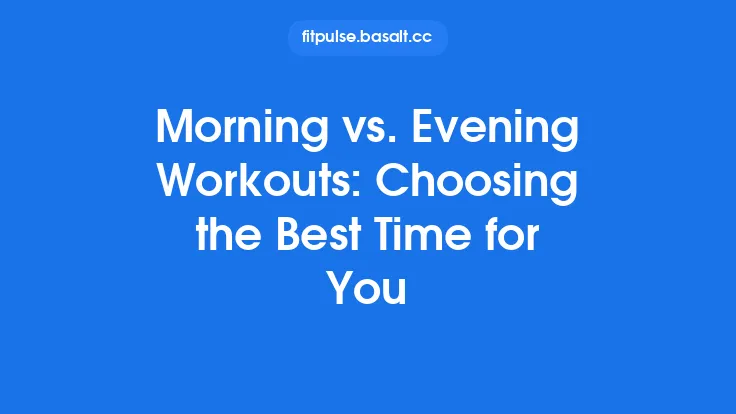When it comes to exercising at home, the clock can feel like a silent coach that either nudges you forward or pulls you back. While many fitness enthusiasts swear by sunrise sessions and others thrive under the glow of evening lights, the optimal time for a home workout isn’t a one‑size‑fits‑all answer. It hinges on how your body’s internal systems interact with the external environment, how you fuel and recover, and how the chosen hour aligns with your daily responsibilities. Below is a comprehensive exploration of the physiological, performance‑related, and practical factors that differentiate morning and evening training, followed by a step‑by‑step method for pinpointing the window that best supports your home‑exercise habit.
Understanding Circadian Rhythms and Exercise
Human physiology follows a roughly 24‑hour cycle known as the circadian rhythm, orchestrated by the suprachiasmatic nucleus (SCN) in the hypothalamus. This internal clock regulates hormone secretion, core body temperature, heart rate variability, and metabolic pathways—all of which influence how the body responds to physical stress.
- Melatonin vs. Cortisol: Melatonin peaks at night, promoting sleep, while cortisol rises sharply within the first hour after waking (the “cortisol awakening response”). Elevated cortisol in the morning can enhance alertness and mobilize energy stores, but excessive levels may also increase catabolism if not balanced with proper nutrition.
- Core Body Temperature (CBT): CBT follows a sinusoidal pattern, reaching its nadir in the early morning (≈ 36.0 °C) and peaking in the late afternoon to early evening (≈ 37.0 °C). Warmer muscles and joints improve elasticity, nerve conduction velocity, and enzymatic activity, which can translate into better performance.
- Chronotype: Individuals naturally fall into “morning larks,” “night owls,” or intermediate types. Chronotype determines the phase angle between the external light‑dark cycle and internal hormonal peaks, influencing perceived energy and motivation at different times of day.
Understanding these rhythms provides a scientific backdrop for why certain performance metrics may fluctuate across the day.
Physiological Advantages of Morning Workouts
- Hormonal Environment Favorable for Fat Oxidation
In the fasted state typical of early‑morning sessions, insulin levels are low, and catecholamines (epinephrine, norepinephrine) are relatively high. This milieu encourages lipolysis, making morning cardio an effective tool for those targeting body‑fat reduction.
- Enhanced Mental Clarity and Decision‑Making
The cortisol surge after waking sharpens focus and can improve reaction time. For skill‑based home workouts—such as kettlebell complexes or body‑weight gymnastics—this heightened alertness may aid technique acquisition.
- Consistency Through Routine Anchoring
While habit formation is outside the scope of this article, the practical reality is that mornings are often less prone to interruptions from work meetings, family obligations, or social events. A workout scheduled before the day’s demands accumulate is less likely to be displaced.
- Positive Impact on Sleep Architecture
Early‑day exercise can advance the circadian phase, leading to earlier melatonin onset and potentially deeper, more restorative sleep—provided the session isn’t excessively intense close to bedtime.
Physiological Advantages of Evening Workouts
- Peak Muscle Strength and Power
Research consistently shows that maximal voluntary contraction (MVC) and power output are highest in the late afternoon/evening, coinciding with the CBT peak. This translates to heavier lifts, faster sprint intervals, and more explosive plyometrics.
- Improved Joint Mobility and Flexibility
Warmer tissues increase the range of motion (ROM) and reduce stiffness. Evening sessions can therefore accommodate more extensive mobility work or yoga flows without the need for prolonged warm‑up periods.
- Greater Anaerobic Capacity
Blood lactate clearance and buffering capacity improve later in the day, allowing higher-intensity interval training (HIIT) or circuit workouts to be performed with less perceived fatigue.
- Nutrient Timing Synergy
Consuming a balanced post‑workout meal or protein shake is easier in the evening when regular meals are already scheduled. This can enhance muscle protein synthesis (MPS) and recovery, especially after resistance training.
Performance Metrics: Strength, Power, and Endurance Across the Day
| Metric | Morning Trend | Evening Trend | Practical Implication for Home Training |
|---|---|---|---|
| Maximal Strength (1RM) | Slightly lower (≈ 5‑10% below peak) | Highest (peak) | Schedule heavy lifting (e.g., barbell squats) in the late afternoon if maximal load is a priority. |
| Power Output (Vertical Jump, Sprint) | Moderately reduced | Significantly higher | Place plyometric or sprint intervals in evening sessions for optimal explosiveness. |
| Aerobic Endurance (VO₂max, Time‑to‑Exhaustion) | Comparable or marginally better in fasted state | Slightly better when glycogen stores are replenished | Choose cardio modality based on goal: fasted fat oxidation (morning) vs. performance‑driven endurance (evening). |
| Perceived Exertion (RPE) | Higher at equivalent workloads | Lower at equivalent workloads | Adjust load or interval length to match subjective effort, especially if training in the morning. |
Injury Risk and Joint Mobility at Different Times
While the evening’s elevated temperature improves flexibility, it can also mask early signs of overuse if the athlete pushes beyond safe limits. Conversely, the cooler morning environment may increase stiffness, raising the risk of strains during rapid movements. Mitigation strategies include:
- Dynamic Warm‑Up Length: Extend the warm‑up by 5‑10 minutes in the morning to raise CBT and lubricate joints. In the evening, a shorter warm‑up may suffice, but still incorporate activation drills to maintain neuromuscular readiness.
- Movement Quality Checks: Perform a brief mobility screen (e.g., overhead squat, hip hinge) at the start of each session to identify time‑of‑day specific limitations.
- Load Management: Consider reducing load by 5‑10% for high‑impact or maximal effort lifts in the early morning, especially if you notice reduced proprioception.
Nutritional Timing and Energy Availability
- Morning Fasted Cardio: If the goal is to accentuate fat oxidation, a 30‑45 minute low‑to‑moderate intensity session (e.g., brisk walking, steady‑state cycling) before breakfast can be effective. Ensure hydration and, if needed, a small caffeine dose (≈ 100 mg) to stimulate lipolysis.
- Evening Resistance Training: Consuming 20‑30 g of high‑quality protein within 30‑60 minutes post‑workout maximizes MPS. Pairing this with a modest carbohydrate portion (≈ 0.5 g/kg) replenishes glycogen and supports subsequent recovery.
- Pre‑Workout Snacks: For morning strength sessions, a light carbohydrate‑protein snack (e.g., banana with a spoonful of nut butter) can offset the catabolic cortisol spike without causing gastrointestinal discomfort.
Sleep Quality and Recovery Considerations
Exercise timing can influence sleep latency and architecture:
- Morning Exercise: Generally promotes earlier sleep onset and can improve sleep efficiency, especially when performed outdoors with natural light exposure.
- Evening Exercise: High‑intensity workouts within 2‑3 hours of bedtime may elevate heart rate and core temperature, potentially delaying sleep onset. However, moderate‑intensity or yoga‑based sessions can be calming and may even enhance sleep quality.
A practical rule of thumb for home trainers is to finish vigorous activity at least 90 minutes before the intended bedtime, allowing physiological parameters to return to baseline.
Practical Home‑Gym Logistics: Space, Light, and Distractions
- Lighting: Natural daylight in the morning can boost mood and alertness. If your home gym lacks windows, consider full‑spectrum LED lights that mimic sunrise for morning sessions and warmer tones for evening workouts.
- Space Availability: Household traffic patterns differ throughout the day. Early mornings may offer a quieter environment for focused strength work, while evenings might be better suited for cardio that tolerates background noise (e.g., treadmill, jump rope).
- Equipment Noise: If you share walls with neighbors, schedule high‑impact or heavy‑weight sessions during times when noise is less likely to cause complaints—often mid‑day or early evening, depending on building policies.
Personalizing Your Optimal Workout Window
- Identify Your Chronotype
Take a simple questionnaire (e.g., Morningness‑Eveningness Questionnaire) to determine whether you naturally feel more energetic in the morning or evening.
- Map Daily Obligations
Plot work meetings, family responsibilities, and other fixed commitments on a weekly calendar. Highlight blocks of at least 45 minutes that remain free.
- Match Exercise Type to Time‑of‑Day Strengths
Morning: Fasted cardio, skill acquisition, low‑to‑moderate intensity strength.
Evening: Heavy lifting, power work, high‑intensity intervals, extensive mobility.
- Consider Environmental Factors
If your home lacks adequate ventilation in the evening, you may prefer morning sessions when fresh air is more accessible.
- Trial Period
Commit to a 2‑week trial of each time slot, keeping a simple log of perceived energy, performance metrics (e.g., reps completed, distance covered), and post‑session soreness. Use this data to decide which window aligns best with your physiological responses and lifestyle.
Testing and Adjusting: A Structured Approach
| Step | Action | Metric to Observe |
|---|---|---|
| 1 | Choose a 7‑day block for morning workouts (e.g., 6 AM–7 AM). | RPE, heart rate, total volume, sleep latency. |
| 2 | Switch to an evening block (e.g., 6 PM–7 PM) for the next 7 days. | Same metrics as above. |
| 3 | Compare averages across the two blocks. | Identify statistically significant differences (e.g., >10% variance in strength output). |
| 4 | Adjust based on findings: if evening strength is markedly higher but morning cardio aligns with fat‑loss goals, consider a hybrid schedule (morning cardio, evening strength). | N/A |
| 5 | Re‑evaluate every 4‑6 weeks to account for seasonal changes (daylight length) and life‑stage shifts (e.g., new job, family changes). | N/A |
This iterative process ensures that your home workout schedule remains dynamic and responsive to both internal physiology and external life demands.
Conclusion: Integrating Time‑of‑Day Insights into Your Home Fitness Plan
Choosing between morning and evening workouts is less about declaring a universal “best” time and more about aligning the unique characteristics of your body’s circadian rhythm with the practical realities of your home environment. By recognizing how hormone levels, core temperature, and metabolic pathways fluctuate across the day, you can strategically schedule cardio, strength, and mobility sessions to capitalize on physiological peaks while minimizing injury risk and sleep disruption.
The ultimate goal is to create a sustainable home‑training rhythm that feels natural, supports performance, and dovetails with your daily life. Whether you rise with the sun to kick‑start your metabolism or prefer the evening glow to lift heavier weights, the key is informed experimentation, attentive listening to your body’s signals, and periodic fine‑tuning. Armed with the science outlined above, you now have a robust framework to determine the optimal workout window that will keep you moving, improving, and thriving within the comfort of your own home.





